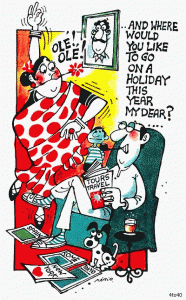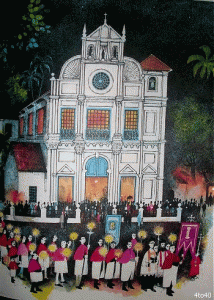 Miranda has been a regular with The Times of India and other newspapers in Mumbai, including The Economic Times, though he got his popularity with his works published in The Illustrated Weekly of India.
Miranda has been a regular with The Times of India and other newspapers in Mumbai, including The Economic Times, though he got his popularity with his works published in The Illustrated Weekly of India.
In a 1999 “Slide Show” on the work of Mario Miranda, the site says: “Nobody is better equipped to capture vignettes of Goan life than Mario Miranda.”
Early life
Mario Joao Carlos do Rosario de Britto Miranda, was born in Daman to Goan Catholic parents of Goud Saraswat Brahmin origin. His ancestral surname was originally Sardessai, before the family converted to Roman Catholicism in the 1750’s. At an early age when his mother saw him drawing his home walls, she brought him a blank book, which he calls his “Diary”. He even started getting into trouble at school, for sketching Catholic priests. Mario Miranda’s early cartoons presented vignettes of Goan village life, a theme he is best known for even today.
He studied at St Joseph’s Boys High School, Bangalore and then did a B.A. in History at St. Xavier’s College, Mumbai, while focusing on the Indian Administrative Service (IAS). Thereafter he started studying architecture at the behest of his parents, though he soon lost interest.
Meanwhile his talent was noticed and his friends encouraged him to make postcards and draw for them, which earned him extra pocket money.
Career & Achievements
 Mario started his career in an Advertising studio, where he worked for four years, before taking up cartooning full-time.
Mario started his career in an Advertising studio, where he worked for four years, before taking up cartooning full-time.
As a cartoonist, he got his first break with The Illustrated Weekly of India which published a few of his works. His drawings & cartoons also brought him an offer to work at the “Current” magazine.
A year later, the Times of India offered him a slot, even though they had rejected him at first. Thereafter, it didn’t take much time for Mario to become a household name, with his creations like Miss Nimbupani, Miss Fonseca appearing on a regular basis in the “Femina”, “Economic Times”, and The Illustrated Weekly of India.
Mario Miranda’s life, was to change after being offered the Fundacao Calouste Gulbenkian Scholarship which enabled him to travel to and stay a year in Portugal and this time in Portugal according to Mario helped him to broaden his horizons.
After a year in Portugal, Mario traveled to London, England and was to spend five years there, learning as well as doing jobs for newspapers and even worked in. of television animation, at Independent Television.
Mario cartoons also featured in the “LILIPUT” and even in other prestigious magazines like “MAD” (once) and “PUNCH” (twice). This supplemented his finances, and enabled him to travel around Europe, interacting with other cartoonists, gaining considerable knowledge and exposure. This led to his meeting of Sir Ronald Searle, whom Mario considered as his mentor.
After five years in England, Mario decided to return to Mumbai and was offered back his old job with the Times of India, where he worked with noted cartoonist, R.K. Laxman.
 Kids Portal For Parents India Kids Network
Kids Portal For Parents India Kids Network







